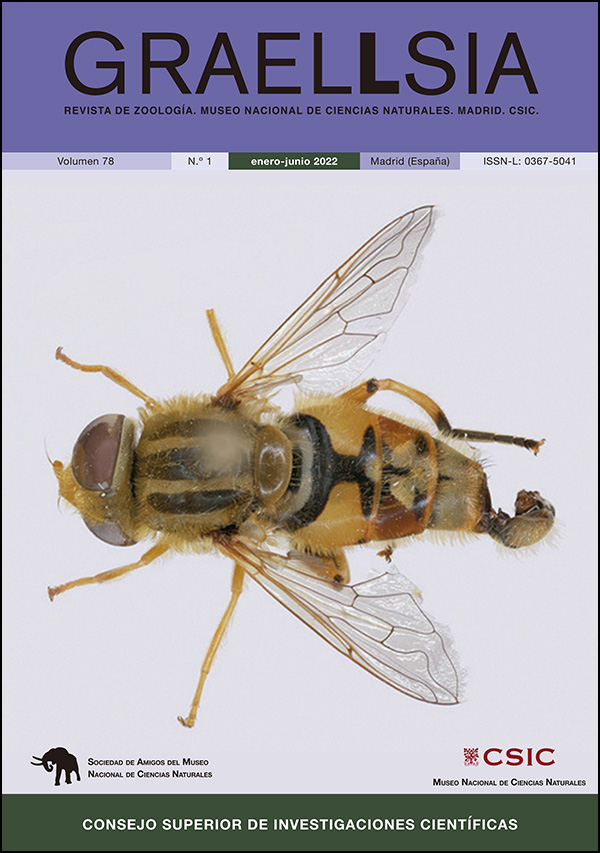Aphis prima sp. n. (Hemiptera, Aphididae), from Argentina and Chile, first aphid species worldwide collected on Schoepfiaceae (Santalales)
DOI:
https://doi.org/10.3989/graellsia.2022.v78.337Keywords:
Aphids, Aphididae, Aphis, Schoepfiaceae, once-branched media, new species, Argentina, ChileAbstract
The study of the first samples of aphids collected on Schoepfiaceae (Santalales) is presented. Aphis prima sp. n. is described from viviparous females collected in the Argentina provinces of Neuquén, Río Negro and Santa Cruz and in Chilean region of Maule on plants of genera Quinchamalium and Arjona, which are endemic to South America. The new species is characterized by the presence of marginal tubercles on 5 or 6 abdominal segments, tibiae homogeneously pigmented and triangular cauda in both apterae and alatae, secondary sensoria on antennal segment III in apterae, and once-branched forewing media in alatae. This last is a very rare characteristic in subfamily Aphidinae.
urn:lsid:zoobank.org:pub:4D8F988D-9D9E-4E67-BA41-037C954C3F20
Downloads
References
Angiosperm Phylogeny Group, 2009. An update of the Angiosperm Phylogeny Group classification for the orders and families of flowering plants: APG III. Botanical Journal of the Linnean Society, 161 (2): 105-121. https://doi.org/10.1111/j.1095-8339.2009.00996.x
Angiosperm Phylogeny Group, 2016. An update of the Angiosperm Phylogeny Group classification for the orders and families of flowering plants: APG IV. Botanical Journal of the Linnean Society, 181 (1): 1-20. https://doi.org/10.1111/boj.12385
Blackman, R. L. & Eastop, V. F., 2021. Aphids on World's plants. An online identification and information guide. Available from http://www.aphidsonworldsplants.info/ (accessed October 2021).
Carver, M., 2000. A new indigenous species of Aphis Linnaeus (Hemiptera: Aphididae) on Muehlenbeckia (Polygonaceae) in New Zealand. New Zealand Entomologist, 22: 3-7. https://doi.org/10.1080/00779962.1999.9722049
Franielczyk-Pietyra, B. & Wegierek, P., 2017. The forewing of the Aphis fabae (Scopoli 1763) (Hemiptera, Sternorrhyncha): a morphological and histological study. Zoomorphology 136: 349-358. h https://doi.org/10.1007/s00435-017-0358-7 PMid:28883685 PMCid:PMC5563516
García Prieto, F. & Nieto Nafría, J. M., 2005. Género Aphis. In: Nieto Nafría, J. M., Mier Durante, M. P., García Prieto, F. & Pérez Hidalgo, N. Hemiptera Aphididae III. In M.A. Ramos et al. (eds.). Fauna Ibérica vol. 28: 30-173.
Hassler M., 2019. World Plants: Synonymic Checklists of the Vascular Plants of the World (version Nov 2018). In: Y. Roskov, G. Ower, T. Orrell, D. Nicolson, N. Bailly, P.M. Kirk, T., Bourgoin, R.E. DeWalt, W, Decock, E. van Nieukerken, J. Zarucchi & L. Penev (eds.): Species 2000 & ITIS Catalogue of Life, 2019 Annual Checklist Digital resource at www.catalogueoflife.org/annual-checklist/2019. Species 2000: Naturalis, Leiden, The Netherlands.
Holman, J., 1966. Contributions to the taxonomy of the genus Aphis (Homoptera, Aphididae) - II. Acta Entomologica Bohemoslovaca, 63 (2): 91-110.
Lagos-Kutz, D., Voegtlin, D.J. & Hartman, G., 2017. Identification of a new species of Aphis (Hemiptera: Aphididae) based on distinct morphology rather than DNA barcoding. Insecta Mundi, 0535: 1-11.
López Laphitz, R. M., Ezcurra, C. & Vidal-Russell, R., 2015. Revisión taxonómica del género sudamericano Quinchamalium (Schoepfiaceae). Boletín de la Sociedad Argentina de Botánica, 50 (2): 235-246. https://doi.org/10.31055/1851.2372.v50.n2.11667
Mier Durante, M. P., Nieto Nafría, J. M. & Ortego, J., 2003. Aphidini (Hemiptera: Aphididae) living on Senecio (Asteraceae), with descriptions of a new genus and three new species. The Canadian Entomologist, 135 (2): 187-212. https://doi.org/10.4039/n02-065
Nieto Nafría, J. M., Brown, P. A., López Ciruelos, S. I. & Ortego, J., 2019. A new species of Aphis (Hemiptera Aphididae) living on Troapaeolum species (Tropaeolaceae) from Chile and Argentina. Redia, 102: 35-40. https://doi.org/10.19263/REDIA-102.19.05
Nieto Nafría, J. M. & Mier Durante, M.P. 1998. Hemiptera Aphididae I. In: M.Á. Ramos et al. (Eds). Fauna Ibérica, Volumen 11. Museo Nacional de Ciencias Naturales, CSIC. Madrid. 424 pp.
Nieto Nafría, J.M. & Mier Durante, M.P., 2013. Acyrthosiphon matilei (Hemiptera Aphididae) in the Cantabrian Mountains (Spain). Boletín de la Asociación Española de Entomología, 37 (3-4): 383-384.
Osiadacz, B. & Hałaj, R., 2010. Systematic Review of Aphids of Poland with Host Plant Index. Silesian Natural History Monographs, 1: 1-191. https://doi.org/10.2478/v10200-011-0014-3
Osiadacz, B. & Hałaj, R., 2015. Aphids in jeopardy? Aphid communities on xerothermic habitats. Biologia, 70: 1118-1135, https://doi.org/10.1515/biolog-2015-0119
Pashchenko, N. F., 1993. Tli roda Aphis (Homoptera, Aphidinea, Aphididae) zhivushchiye na rasteniyakh semeytv Lamiaceae, Limoniaceae, Onagraceae, Polemoniaceae, Primilaceae i Santalaceae na Dal'nem Vostoke Rossii {Aphids on the genus Aphis […] living on plants of the families […] in the Russian Far East}. Zoologicheskiy Zhurnal, 72 (10): 41-53.
Vidal-Russell, R., 2019. Phylogenetic Relationships in Arjona (Schoepfiaceae), a hemiparasitic herb from Southern South America. Systematic Botany, 44 (3): 592-599. https://doi.org/10.1600/036364419X15620113920626
Published
How to Cite
Issue
Section
License
Copyright (c) 2022 Consejo Superior de Investigaciones Científicas (CSIC)

This work is licensed under a Creative Commons Attribution 4.0 International License.
© CSIC. Manuscripts published in both the print and online versions of this journal are the property of the Consejo Superior de Investigaciones Científicas, and quoting this source is a requirement for any partial or full reproduction.
All contents of this electronic edition, except where otherwise noted, are distributed under a Creative Commons Attribution 4.0 International (CC BY 4.0) licence. You may read the basic information and the legal text of the licence. The indication of the CC BY 4.0 licence must be expressly stated in this way when necessary.
Self-archiving in repositories, personal webpages or similar, of any version other than the final version of the work produced by the publisher, is not allowed.














